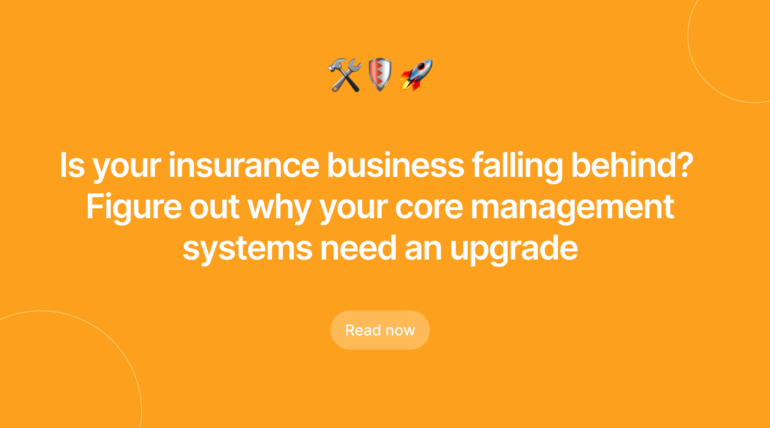
Verified Market Research reports a substantial valuation of around $9.15 billion for the global insurtech niche in 2020, and industry analysts foresee a significant uptick, reaching $16.36 billion by 2028. This growth underscores the swift evolution and widespread embrace of digital solutions across diverse insurance sectors.
The consequences for businesses trailing behind in this digital revolution are clear – a potential loss of competitive edge. The outdated legacy insurance core systems are at the heart of this challenge, demanding excessive maintenance, attention, and financial resources. This drains crucial time and effort that could fuel a company’s competitive performance.
Statista predicts that by 2030, specialized digital systems will have taken over more than 45% of current insurance jobs across the United States.
In essence, the shifting landscape of insurtech demands a critical evaluation of legacy systems. It’s not just about keeping up; it’s about ensuring the vitality of core management systems to navigate and thrive in this dynamic industry.
As a result:
Legacy software foundations pose a significant obstacle for insurers striving to align with modern business strategies and models. The inefficiencies they introduce can directly translate into revenue loss, making it crucial for companies to reassess their technological underpinnings.
Beyond the financial implications, outdated systems also present user-centric challenges. Often unable to provide real-time information, these systems need to meet the expectations of today’s users. This deficiency affects customer satisfaction and contributes to the loss of existing clients and the potential deterrence of new ones.
The need for more user-friendly features and a seamless user experience further compounds the problem. Insurers find themselves in a precarious position, grappling with the repercussions of systems that no longer meet the evolving expectations of their clientele. The consequence? A direct hit on client retention and acquisition efforts.
Despite the evident challenges, the prospect of overhauling these existing systems looms large. While such a transformation can be technically challenging and time-consuming, the potential advantages of a more agile and responsive infrastructure make the effort well worthwhile. It’s a strategic move that addresses the current shortcomings and positions insurers for sustained success in an ever-evolving landscape.
Insights from Novidea, an insurance management platform, suggest a looming wave of upgrades in core insurance management platforms over the next two years. This revelation comes from their latest research report, “Legacy Out, Digitization In: The State of Modern Insurance Technologies 2024,” aggregating responses from 330 insurance leaders across eight countries. The comprehensive survey, conducted online in October of the previous year by Global Surveyz Research, unveils compelling trends shaping the insurance tech landscape.
The research highlights a prevailing reliance on multiple systems among insurers for core processes such as claims, billing, policy distribution, and underwriting. On average, insurers employ around five systems, with larger companies with over 5,000 employees utilizing six to ten systems. Notably, 38% of respondents express dissatisfaction, citing that their existing systems need more comprehensive functionalities essential for seamless insurance operations.
Furthermore, the survey reveals a compliance gap, with less than a quarter of respondents stating their current systems adequately support compliance needs. A staggering 77% note that their technology only proves helpful sometimes. These findings underscore a pivotal moment in the insurance industry, signalling a growing recognition of the need for technological evolution to stay competitive and compliant in a dynamic landscape.
In correspondence with Digital Insurance, Eric Ayala, Managing Director at Novidea, underscored a crucial moment for insurance leaders. The data, he noted, reveals a narrative of decision-makers standing at a crossroads. They acknowledge that their legacy tech systems hinder successful transformation and modernization. While concerns about potential business interruptions and upgrade costs may have delayed action in the past, Ayala emphasizes a shift in perspective. The current landscape, marked by intense competition and heightened customer expectations, leaves no room for the status quo. Ayala suggests that the imperative for change is now undeniable.

Key insights:
1. Hesitation in system updates
Approximately three-fourths of respondents express reservations about updating their systems.
2. Top reasons for hesitation
- Cost ranks as the primary concern for 48% of respondents.
- Compatibility issues with existing systems worry 42%.
- Concerns about customer adoption are voiced by 38%.
- The time required for training is a consideration for 30%.
- Fear of business interruption is a factor for 28%.
3. Challenges with current technology systems
- Data quality is a significant concern for 41% of respondents.
- Data privacy and security rank high, cited by 35%.
- Another 35% notes scale issues.
Tips to consider before upgrading to a new core system
Upgrading your core insurance system is a significant decision, and exploring the choices requires careful consideration. Here are essential tips to guide you through the process:

1. Standard vs custom software
When choosing a new core solution, decide between standard software and a custom build/low code approach. Standard software meets common needs, while custom solutions cater to unique requirements. Consider whether you want to follow market best practices (standard) or design your solutions (custom). This decision shapes your strategy and influences system compatibility.
2. Perform a Proof of Concept
Before committing, conduct proof-of-concept tests and small-scale demonstrations. This hands-on approach allows insurers to envision how the system aligns with business objectives, assess integration into existing systems, and evaluate critical features. It’s an opportunity to test user interfaces, data management, and functionality crucial to strategic goals.
3. Look forward, not backwards
Craft a clear future business strategy to ensure the chosen solution aligns with long-term goals. Rather than mapping current functionalities onto the new system, embrace an ‘adopt over adapt’ strategy. This approach emphasizes adopting processes that drive positive changes, fostering organizational growth and operational ease.
4. Migrations matter
Choose a vendor with expertise in performing migrations. Successful data migration from legacy to new systems is complex and critical. An experienced team understands the complexities, including data quality, mapping, and transformation. This ensures a smooth transition with minimal disruption to business operations.
5. Understanding SaaS vs On-Premise solutions
Differentiate between Software-as-a-Service (SaaS) and on-premise solutions. SaaS, being cloud-based, is generally less expensive, with shared development and maintenance costs. Consider factors like flexibility, scalability, and security when deciding between SaaS, hosted by the vendor, and on-premise solutions run on the organization’s servers.
6. Try before you buy
Beyond proof of concepts, insist on seeing working functionality rather than slides or presentations. Focus on specific use cases important to your business, allowing you to experience the software in action. Avoid enforcing ‘how’ something should be done, enabling you to explore the solution’s full potential.
7. The right cultural fit
Acknowledge the importance of a good cultural fit between your organization and the software vendor. Long-term partnerships thrive on shared values, work ethics, and cultural expectations. A harmonious cultural fit fosters collaboration, open communication, and a higher likelihood of project success.
In conclusion, upgrading your core insurance system involves more than just technology—it’s about aligning with your long-term goals, understanding the software’s functionality, and building a strong cultural fit with your vendor. Embrace these considerations to ensure a seamless transition that meets your current needs and prepares you for future disruptions and growth.







